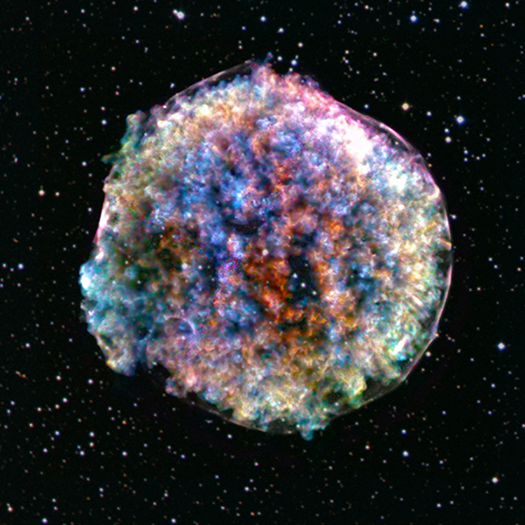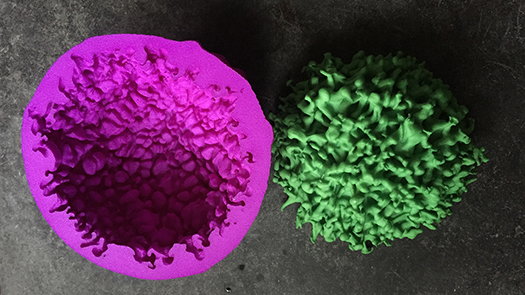Tycho's Supernova Remnant: The Clumpy and Lumpy Death of a Star
In 1572, Danish astronomer Tycho Brahe was among those who noticed a new bright object in the constellation Cassiopeia. Adding fuel to the intellectual fire that Copernicus started, Tycho showed this "new star" was far beyond the Moon, and that it was possible for the Universe beyond the Sun and planets to change.
Astronomers now know that Tycho's new star was not new at all. Rather it signaled the death of a star in a supernova, an explosion so bright that it can outshine the light from an entire galaxy. This particular supernova was a Type Ia, which occurs when a white dwarf star pulls material from, or merges with, a nearby companion star until a violent explosion is triggered. The white dwarf star is obliterated, sending its debris hurtling into space.
As with many supernova remnants, the Tycho supernova remnant, as it's known today (or "Tycho," for short), glows brightly in X-ray light because shock waves — similar to sonic booms from supersonic aircraft — generated by the stellar explosion heat the stellar debris up to millions of degrees. In its two decades of operation, NASA's Chandra X-ray Observatory has captured unparalleled X-ray images of many supernova remnants.
Chandra reveals an intriguing pattern of bright clumps and fainter areas in Tycho. What caused this thicket of knots in the aftermath of this explosion? Did the explosion itself cause this clumpiness, or was it something that happened afterward?
This latest image of Tycho from Chandra is providing clues. To emphasize the clumps in the image and the three-dimensional nature of Tycho, scientists selected two narrow ranges of X-ray energies to isolate material (silicon, colored red) moving away from Earth, and moving towards us (also silicon, colored blue). The other colors in the image (yellow, green, blue-green, orange and purple) show a broad range of different energies and elements, and a mixture of directions of motion. In this new composite image, Chandra's X-ray data have been combined with an optical image of the stars in the same field of view from the Digitized Sky Survey.
By comparing the Chandra image of Tycho to two different computer simulations, researchers were able to test their ideas against actual data. One of the simulations began with clumpy debris from the explosion. The other started with smooth debris from the explosion and then the clumpiness appeared afterwards as the supernova remnant evolved and tiny irregularities were magnified.
A statistical analysis using a technique that is sensitive to the number and size of clumps and holes in images was then used. Comparing results for the Chandra and simulated images, scientists found that the Tycho supernova remnant strongly resembles a scenario in which the clumps came from the explosion itself. While scientists are not sure how, one possibility is that star's explosion had multiple ignition points, like dynamite sticks being set off simultaneously in different locations.
Understanding the details of how these stars explode is important because it may improve the reliability of the use of Type Ia supernovae "standard candles" — that is, objects with known inherent brightness, which scientists can use to determine their distance. This is very important for studying the expansion of the universe. These supernovae also sprinkle elements such as iron and silicon, that are essential for life as we know it, into the next generation of stars and planets.
A paper describing these results appeared in the July 10th, 2019 issue of The Astrophysical Journal and is available online. The authors are Toshiki Sato (RIKEN in Saitama, Japan, and NASA's Goddard Space Flight Center in Greenbelt, Maryland), John (Jack) Hughes (Rutgers University in Piscataway, New Jersey), Brian Williams, (NASA's Goddard Space Flight Center), and Mikio Morii (The Institute of Statistical Mathematics in Tokyo, Japan).
Another team of astronomers, led by Gilles Ferrand of RIKEN in Saitama, Japan, has constructed their own three-dimensional computer models of a Type Ia supernova remnant as it changes with time. Their work shows that initial asymmetries in the simulated supernova explosion are required so that the model of the ensuing supernova remnant closely resembles the Chandra image of Tycho, at a similar age. This conclusion is similar to that made by Sato and his team.
A paper describing the results by Ferrand and co-authors appeared in the June 1st, 2019 issue of The Astrophysical Journal and is available online.
Category:
- Log in to post comments


